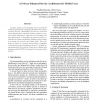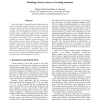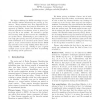PERCOM
2005
ACM
15 years 2 days ago
2005
ACM
Sensor networks are large scale networks of low-power devices that collaborate in order to perform a given task. The sensors are limited in battery energy, capacity and computatio...
PERCOM
2005
ACM
15 years 2 days ago
2005
ACM
Many applications in eLearning utilize wireless networks (WLAN) as a carrier for data and communication. These networks in their basic form are insecure, protecting the communicat...
PERCOM
2005
ACM
15 years 2 days ago
2005
ACM
We propose a hybrid model to alleviate the notorious problem of premature battery depletion in sensor networks: in a first stage, simple sensors are deployed over an area of inter...
PERCOM
2005
ACM
15 years 2 days ago
2005
ACM
When analyzing dissemination protocols in mobile adhoc networks the underlying mobility model is an important factor because it strongly influences the performance of these protoc...
PERCOM
2005
ACM
15 years 2 days ago
2005
ACM
Location, presence and messaging services provide the essential ingredients for emerging information and communications services. Nevertheless, the users are concerned about revea...
PERCOM
2005
ACM
15 years 2 days ago
2005
ACM
In the last decade, e-learning has been introduced to a variety of blended learning scenarios, such as life-long learning, University lectures, and game-based learning. In all the...
PERCOM
2005
ACM
15 years 2 days ago
2005
ACM
Distribution of media in the fast growing world of digital stored content and multimedia supporting devices with connectivity, calls for a new media distribution architecture. The...
PERCOM
2005
ACM
15 years 2 days ago
2005
ACM
The mass market of wireless devices is pushing towards service provisioning over dense Mobile Ad-hoc NETworks (MANETs), i.e., limited spatial regions, such as university campuses,...
PERCOM
2005
ACM
15 years 2 days ago
2005
ACM
The biggest challenge for RFID technology is to provide benefits without threatening the privacy of consumers. Many solutions have been suggested but almost as many ways have been...
PERCOM
2005
ACM
15 years 2 days ago
2005
ACM
Pervasive Computing environments require new communication and programming paradigms. In this paper we present our experiences from the implementation of MundoCore, a pervasive co...





